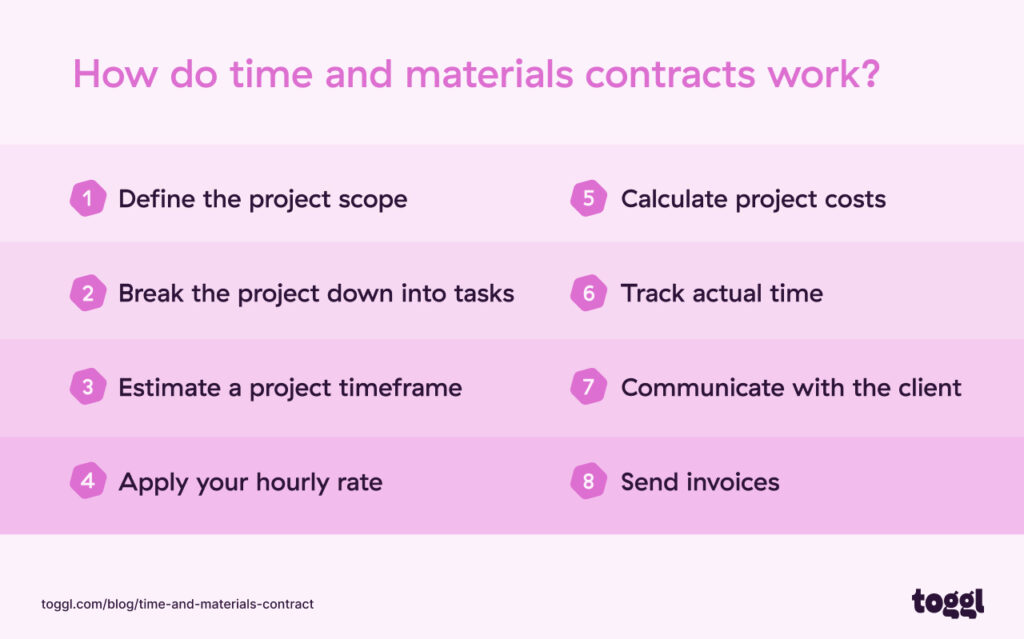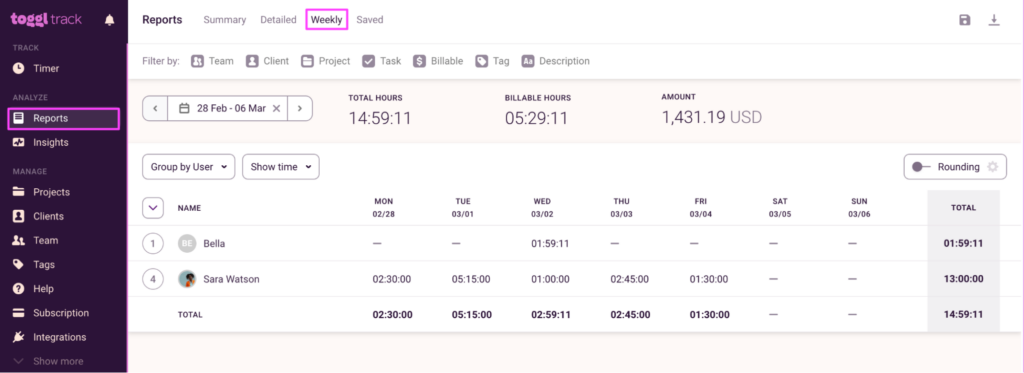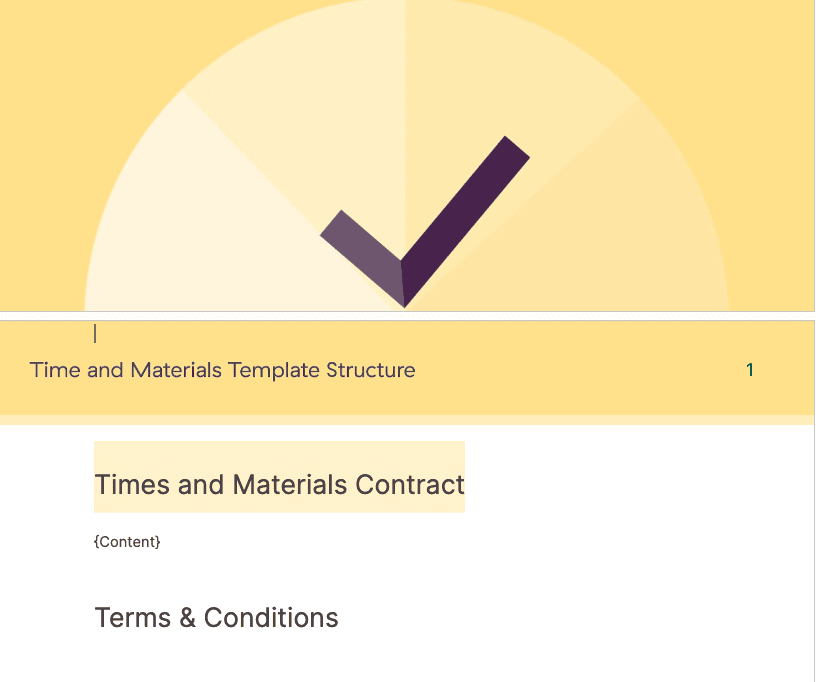A time and materials contract is a legally binding agreement that establishes a project’s cost based on the time taken and the material prices used to complete it.
This contract type is common across multiple industries—e.g., construction contracts, product development contracts, and accounting contracts.
If you’re intrigued, let’s explore:
- How these contracts work
- When to use a time and materials contract
- Pros and cons of T&M contracts
Plus more!
Let’s get started.
What is a time and materials contract?
A time and materials contract (aka T&M contract) is an agreement between a client and a service provider where the client pays for the actual time and materials spent to complete a project.
The “actual time” = the number of hours spent working on the entire project.
This number is then multiplied by the agreed-upon hourly rate, and the resulting total is added to the cost of materials.

What is an example of time and materials pricing?
To get a clearer picture of how T&M pricing works, here’s a quick example:
A client hires a web development agency to help create a new website.
The graphic designer and developers take 80 hours to complete the project. The fixed hourly rate for their services is $50. That would make a total of $4,000.
In addition to these labor costs, the client must pay $400 for project expenses; the purchase of direct materials like premium stock photos or licensed fonts.
The final price of this time and materials contract will be $4,400.
How do time and materials contracts work?
Here’s a step-by-step example of how a time and materials contract could work for you:

- Define the project scope: You need to know what the client wants, key dates or goals, and what they expect.
- Break the project down into tasks: Use a Work Breakdown Structure to make the project more manageable.
- Estimate a project timeframe: Create time estimates for each task. Similar past projects can help you here as a reference.
- Apply your hourly rate: Total up all hours needed to complete the project and multiply by your hourly rate.
- Calculate project costs: Work out other costs for the project. Such as licensing fees, etc., and add that to your cost estimate.
- Track actual time: Keep track of how much time you are working on the project. A time tracking tool like Toggl Track can help you do this.
- Communicate with the client: Keep in touch with the client about how the project is going and communicate any changes.
- Send invoices: On a weekly or monthly basis, send the client an invoice for the hours worked and any indirect costs.
You should let the client know that your estimates are, in fact, just estimates and not a fixed cost.
Review task estimates and actuals regularly and communicate any significant deviations to the client.
When to use a time and materials contract
Here are two common scenarios when time and materials contracts may be appropriate:
- When the project scope is unclear or likely to change over time.
Let’s say a design agency starts working with a startup company that is still refining its vision and target audience.
They might benefit from a T&M contract that offers flexibility in the design process.
If client preferences or needs change, which is most likely to happen for a startup company, it’s much easier to address them in a T&M agreement.
- When you deal with customization and complex tasks.
For example, let’s say you work on a project that involves complex software development and customization.
In this case, a T&M contract enables you to make quick changes if something unforeseen comes up or provide ongoing support throughout the project.
However, if neither scenario resonates with you, you may want to consider other contract types.
Let’s look at some below.
Time and materials vs. fixed fee contract
Let’s look at some of the most relevant differences between time and materials and fixed fee contracts:
Pricing structure
T&M pricing is based on the actual time spent on a project plus the materials used to complete the project.
In a fixed fee or lump sum contract, the maximum cost of the project is predetermined and does not depend on the time spent to complete it.
Flexibility
Time and materials contracts allow you to change the project’s scope or requirements throughout the project.
Fixed-fee contracts are less flexible. They rely on well-defined scopes and set conditions.
Cost control
With T&M contracts, handling cost control is challenging as project requirements and required resources may change over time.
It’s easier to control costs in a fixed-fee contract since the project budget is predetermined.
Time and materials vs. value-based contract
Here are some of the most common differences between T&M and value-based contracts:
Pricing structure
Compared to T&M, value-based pricing varies based on the “value” that a service brings to the client. The higher the perceived “value,” the more you can charge.
Flexibility
Value-based contracts focus on outcomes and value delivered.
As long as you meet the expectations of your clients, the way you do things or what goes into it doesn’t matter much.
Cost control
Value-based pricing can be a bit of a wild card for keeping costs under control.
That’s because it’s not about the actual cost of things. It’s more about what people think something should be worth.
Parts of a time and materials contract:
Not sure what goes into a time and materials contract?
Here’s a list of items to consider:
- Contractor’s responsibilities: The scope of work, number of labor hours, and materials necessary.
- The project’s completion schedule: Estimated milestone time frames and overall project duration.
- Pricing and payment: Hourly labor rates (including weekend rates and overtime), the actual cost of materials, etc.
- Change requests: How changes will be handled, evaluated, and priced.
- Termination conditions: Provisions for mediation, arbitration, or litigation if conflicts arise.
- Confidentiality terms: How to handle confidential information, intellectual property rights, and data protection.
- Limitation of liability clause: The extent to which the contractor’s liability is limited in case of damage or loss.
- The governing law that will apply to the contract.
Stay tuned for a free time and materials template below!
Advantages and disadvantages of time and materials contracts
The biggest advantage of time and materials contracts is the safety of making a profit from projects.
But if you look past the obvious pros, you’ll see that this type of contract can actually slow business growth. 😬
Advantages
- They offer more flexibility.
Unlike fixed price contracts, T&M contracts allow you to make project scope or requirement changes as the project timeline advances.
- Less risk of reduced profits.
With T&M contracts, you don’t have to worry about wrong estimates or scope creep. You can adjust to maintain profitability when changes occur in project variables or scope changes occur.
- Profits are more closely aligned with the scope of work.
In other words, your profit margins are directly proportional to the actual work you put in.
Disadvantages
- Tracking billable hours can be challenging
Keeping analog records of how much time your team spends working on a project is time-consuming and, quite frankly, boring.
With a tool like Toggl Track, you can say goodbye to those burdensome administrative tasks and track every billable hour as you work with just one click.
- Type in your “time entry description.”
- Find your client
- Select what “project” you’re working on
- Start the timer
Easy!

Can limit growth
Although T&M contracts can improve profitability, they can also hinder your ability to scale and take on larger projects.
By being limited to as many jobs as you can fit into the work week, you risk losing potential clients and projects (and money).
Clients may feel concerned
Clients often worry that T&M contracts could lead to paying too much or getting charged for inefficient work.
This concern increases when there’s no trust or if it’s the client’s first time working with the agency.
One way to address this concern is by using a strong time reporting system to provide clients with insightful reports on how and when your team works
With Toggl Track, you have access to Summary Reports, Detailed Reports, and Weekly Reports you can send clients to give them insights into where you’re spending your time.

Giving clients access to time reports can help build trust and provide them with peace of mind that every minute spent working on their project is tracked and shared in weekly or monthly detailed reports.
Free time and materials contract template
As promised, here’s our free time and materials contract template.
The template contains all the essential elements that need to go into a time and materials contract, such as project scope, timeline, rates, payment terms, liability clauses, etc.

Now over to you.
If used correctly, time and materials contracts can give you the flexibility you need without compromising business profitability.
With the insights and tools provided above, you’re more than ready to enjoy the full potential of T&M contracts. Good luck!
Don’t forget that Toggl Track can help you track time and project profitability, bill accurately, and effectively manage workflows.
Work tools to elevate your productivity – apps for incredibly simple time tracking and effective project planning.


